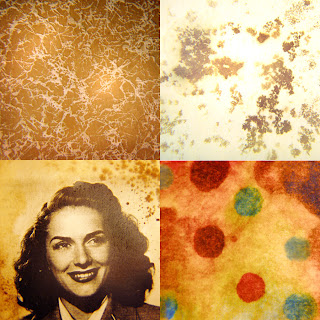Let's Color, Kids!
Altering papers and printed images to use in collage is easy: Stain, paint, tear, stitch, dye, burn, bleach, or scratch them for effect. Of course you can create dimensional paper, too, by folding, pleating, crumpling, and more.
 |
| Rolled, crumpled, creased, pleated, scored. |
 |
| Strong coffee, wet tea leaves, walnut crystals, alcohol ink. |

Tip: I saturate papers with rubbing alcohol before applying alcohol inks. Then I immediately soften and spread the ink with a brush or piece of felt dipped in rubbing alcohol.
 |
| The finished papers after colorizing them. |
 |
Bleached spots at left, scratched selectively at right. |
Abrading a surface lends an aged, distressed appearance. To scratch the emulsion of a commercially-processed photograph, soften it in a tray of warm water for a minute. Blot it on a hard, flat surface and scrape away with a large needle, nail, or other scratch tool. Sandpaper removes large areas quickly. The light-colored marks show up best in dark areas of the photo.
And finally, do try this: Décollage is an art term that refers to a cutting and tearing technique based on the appearance of layered posters on billboards. The result leaves shredded papers, revealing portions of the images and text underneath.
 |
| Decollage example |



























As always, interesting ideas. I wonder if using hydrogen peroxide instead of bleach would work, and be safer? I have no clue, but I'm throwing the idea out there.
ReplyDeleteThanks for the idea, my dear, yet as a longtime blonde by choice I have to say I don't think it would work, but I'd love for someone to try it and prove me wrong! Really, thanks!
ReplyDeleteThanks for the interesting techniques! Really want to try the last one for sure!
ReplyDeleteYes! Lots of fun. Great blog and thanks for sharing.
ReplyDelete